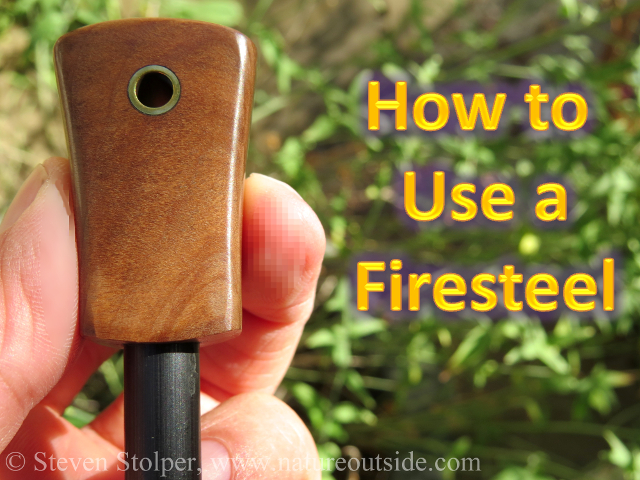
Firesteels are one of the most important inventions in outdoor gear in the last 50 years. And once you get to know them, you will appreciate the advantages of carrying one in the backcountry.
Firesteels start fires. Like other ignition sources (i.e. matches, lighters) their job is to start your tinder burning. The firesteel consists of a metal rod usually attached to a small handle.
The metal is a cerium alloy mixed with an iron alloy to provide strength. This combined alloy is called mischmetal. The first firesteels had a slightly different formulation, called ferrocerium. Mischmetal has pyrophoricity. A pyrophoric substance (from the Greek “fire-bearing”) ignites spontaneously in air at or below 55 °C (130 °F). When you scrape a sharp surface against a firesteel, it gives off hot sparks.
And when I say “hot” I mean HOT! This is not your father’s magnesium block. When scraped, a firesteel produces molten sparks of 3000°C (5,500°F)!
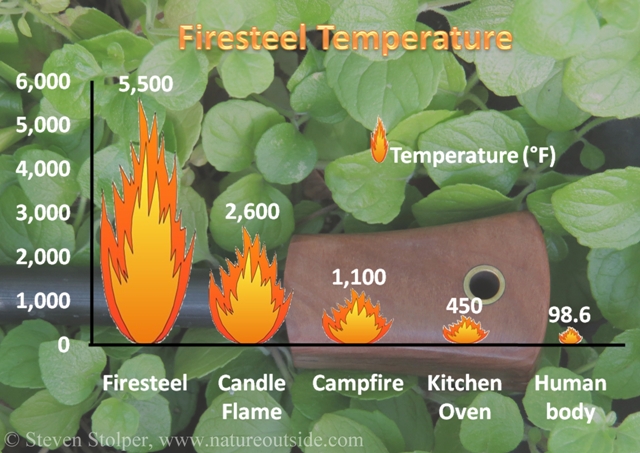
Relative temperature of sparks thrown by a firesteel
The Advantages of Using a Firesteel
There are several compelling reasons to use a firesteel: It works when wet, it’s reliable, it’s easy to carry and lights many fires.
Survives Immersion in Water
Get a firesteel wet and it still lights fires. Try that with matches or a cigarette lighter!
Easy to Carry / Lights many fires
A single ¼-inch firesteel can ignite 12,000 fires. Think how many matches you would need to carry to light 12,000 fires!
Reliable! Reliable! Reliable!
Besides immersion in water, cigarette lighters can run out of fuel or break. Matches can break or you can lose the striker material (for safety matches). Matches and lighters also do poorly in high winds.
Choosing and Caring for your Firesteel
Some links below are affiliate links.
You can purchase a firesteel at most outdoor stores and on the Internet. The most popular brand as of this writing is the Swedish brand, Light My Fire. They are high quality and well constructed. Light My Fire makes several models in various sizes and with different color handles.
You can buy “no-name” brands on the Internet. But formulation varies from brand-to-brand. A softer formulation throws larger sparks, but wears faster. A harder formulation throws smaller sparks but is more durable. Some of the cheapest firesteels have much less of the pyrophoric rare-earth metals. As a result, they throw poor sparks. So buyers beware!
Don’t skimp on survival equipment. Because when you need it, you really need it! You would pay any price to have it work.
Get a Grip!
You can also purchase firesteels with custom wood handles. These are decorative and many people get them to match the wood scales on their bushcraft knives. Firesteel “blanks” are also available. These are rods that don’t have a handle attached. You can fashion a handle yourself and glue the rod into it. This makes a terrific rainy-day project!
Scrapers and Knives
More expensive firesteels come with scrapers you can use to throw sparks. But the spine of my bushcraft knife works best for me. Scraping the edge of my knife’s spine against the rod throws enormous sparks. And my bushcraft knife is always at my hip when I’m in the backcountry.
My knife is specifically designed for use with a firesteel. The edges of the spine are squared 90-degrees. Scraping with an edge of the spine throws amazingly large sparks! But not all knives are designed for use with a firesteel. For example, many models of the popular Mora knives have rounded spines. They slide along the firesteel without generating sparks. You should consider this when you select a bushcraft knife.
If you ever find yourself in an emergency where you need to use your firesteel, you always have the option of using the blade of your knife against the firesteel. But this carries the risk of dulling or chipping your blade. You can even use a sharp rock!
Coatings and Care
Most firesteels ship with a black coating that prevents the iron in the rod from rusting. You have to scrape through this coating before the steel will generate large sparks. Although firesteels are durable, you should be careful not to store them wet. The rod can oxidize or develop pits.
I carry my firesteel in a special loop on my knife sheath. But when I store one in my pack I make sure it will not scrape against hard equipment. This will cause premature wear.
Tinder is the Catch
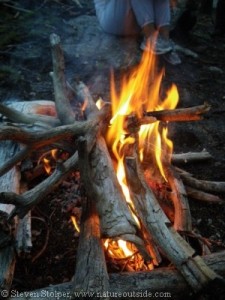 Firesteels are not perfect. They work best with tinder that is able to catch a spark. Matches and lighters provide a constant flame that you can use to dry and ignite your tinder. But firesteels require dry tinder that is wispy enough to start burning when a spark falls on it. Try this example (safely): Tear an 8.5×11” sheet of paper in half. Try lighting half of it with a match or cigarette lighter. Use a firesteel to light the other half. You will see the difficulty.
Firesteels are not perfect. They work best with tinder that is able to catch a spark. Matches and lighters provide a constant flame that you can use to dry and ignite your tinder. But firesteels require dry tinder that is wispy enough to start burning when a spark falls on it. Try this example (safely): Tear an 8.5×11” sheet of paper in half. Try lighting half of it with a match or cigarette lighter. Use a firesteel to light the other half. You will see the difficulty.
Natural tinders that are “fluffy” or “wispy” work best with a firesteel. Feathery seed cases like cattail down or clematis seeds work well. They explode with a “poof” and burn so rapidly that I always mix in other dry material to sustain the flame.
Old Man’s Beard lichen (Usnea) works well. I often collect some at the start of my hike and slip it into my pants pocket. My body heat dries it as I hike so it is ready to use at the end of the day. Fine bark and wood shavings also will catch a spark. But depending on your region, these may not make ideal tinder. I scrape them with the blade of my knife to get thin shavings that will ignite. Think fluffy or wispy!
Artifical tinder works great! My favorite is cotton balls rolled in petroleum jelly. I carry them in an old 35 mm film canister. I also like a commercial tinder called, Wetfire. These small cubes fit easily into my personal survival kit. But Wetfire has a definite shelf life! After several years I find the volatile chemicals evaporate through the packaging. You can also use firesteels to ignite candles and cotton dryer lint.
An effective technique with damp or poor tinder is to scrape flakes of the firesteel material onto/into the tinder before you try to ignite it. You can use the spine of your knife or your scraper to slowly and deliberately scrape slivers of the material onto the tinder without generating sparks. When you do strike the firesteel (see below), the slivers will glow with heat or sizzle and spit when sparks fall on them. This helps the tinder to catch.
Firesteel Technique 1: Moving the Knife
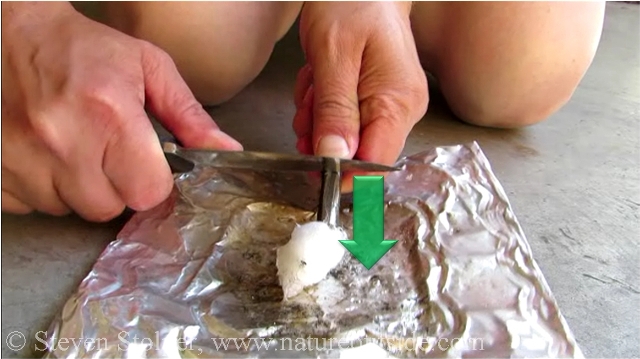
Scraping down the rod with the spine of your knife
The standard technique for using a firesteel is to scrape downward with your knife or scraper. Here are the steps and a video that illustrates the technique:
Step 1:
Grip the handle of the firesteel between your thumb on top and the side of your index finger below.
Step 2:
Hold your knife as if you are going to use the chest-lever grip. Align your knuckles with the bottom of the knife handle and place your thumb against the side of your knife blade.
Step 3:
Hold the spine of your knife against the firesteel rod near the handle of the firesteel. Rotate the knife away from the handle so the edge of the spine nearest the tinder will dig into the rod.
Step 4:
Squeeze the handle with your index finger against the palm of your hand as you move your thumb against the side of the knife blade, closest to the handle. Your two thumbs should be on the side of the blade closest to you.
Step 5:
Place the end of the firesteel rod on top of the tinder or against it. For lightweight tinder, you can hold it down with the end of the firesteel rod to keep it from blowing away in the wind.
Step 6:
Scrape the spine of your knife down the length of the rod by pushing with your thumbs. The thumb of the hand holding the firesteel does not need to remain in contact with the blade as it travels the length of the rod. The hand holding the knife will move away from you, toward the tinder.
It is difficult to visualize the motion from a picture. So here is a video of me lighting a cotton ball coated with petroleum jelly. There is no need to scrape quickly. But in the video I go fast out of habit. I suspect I was anxious about being filmed.
Firesteel Technique 2: Moving the Firesteel
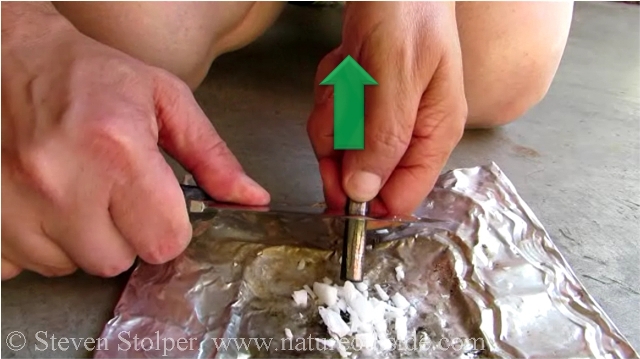
Pulling the firesteel away from the tinder while scarping it against the spine of your knife
Often the tinder is light and fluffy. Or it may be in small pieces or shavings. You do not want the tinder to go flying if your knife hits it as you scrape down the rod. So instead of scraping your knife down the firesteel, you can pull the firesteel away from your tinder, against the knife.
Here are the steps and a video that illustrates the technique:
Step 1:
Grip the handle of the firesteel between your thumb on top and the side of your index finger below.
Step 2:
Hold your knife as if you are going to use the chest-lever grip. Align your knuckles with the bottom of the knife handle and place your thumb against the side of your knife blade.
Step 3:
Hold the spine of your knife against the firesteel rod, ½ – ¾ the way up from the end of the rod. Rotate the knife away from the handle so the edge of the spine nearest the tinder will dig into the rod.
Step 4:
Place the end of the firesteel near the tinder, being careful not to disturb it.
Step 5:
Pull the handle of the firesteel toward you. As you pull, scrape the rod against the spine of your knife.
Again, a picture is not sufficient to demonstrate the motion. Here is a video of me lighting small pieces chopped from a Wetfire tablet. I go faster than necessary out of (bad) habit.
Firesteel Technique 3: One-handed Fire Starting
The techniques I’ve shown so far require you to use both hands. But what if you injure one of your hands?
It’s important to know how to start a fire using just one hand. Here is a terrific video by John McCann, owner of Survival Resources. John illustrates a one-handed fire starting technique using a firesteel. It’s simple, practical, and easy to use. If you carry a firesteel, it’s something you should know.
The Biggest Mistakes Beginners Make
Get Down!
I was traveling for business and had an hour to kill at the hotel. I flipped the television on and ran across a popular “survival” show. One of the “characters” (I won’t call them experts) was attempting to light a pile of wood shavings using a firesteel. The conditions were wet and he needed the fire to keep warm.
What he did next amazed me. Kneeling in front of his tinder pile, he started sawing away at the firesteel with the spine of his knife. But the firesteel was up by his bellybutton!
“Get Down!” I yelled at the television, like a crazed football fanatic. He grunted with the effort. But none of his sparks found the pile of tinder. Eventually a lucky spark ignited the fire and everyone lived happily ever after.
I realize after the fact that holding the firesteel high above the tinder gave the cameras a better vantage to see the sparks. It also made it much harder to light the fire, which added to the drama. But you don’t need that kind of drama!
Avoid the biggest mistake I see beginners make. Get the firesteel as close to the tinder as possible! Get the rod in among the tinder. Use the rod to hold down the tinder as you scrape it. Do everything you can to guide the sparks to their target.
Slow Down!
Inexperienced people scrape the firesteel too fast. They don’t exert enough pressure with the spine of their knife and the result is weak sparks. Use a slow to moderate stroke and apply pressure with the spine of your knife against the firesteel. As you become experienced, you will find a “sweet spot” of speed and pressure. I’m embarrassed by how quickly I went in the videos. I suspect I went faster because I knew I was being filmed.
How to Practice
Practice makes perfect. And like other skills, you should practice using a firesteel. I purchase cheap disposable aluminum foil baking pans. I cut into the sides of the pans at the corners and fold-over the sides. This creates a raised metal platform.
I place different types of tinder on the pans and practice lighting them with my firesteel. The metal pans keep the burning tinder from spreading flames to material nearby.
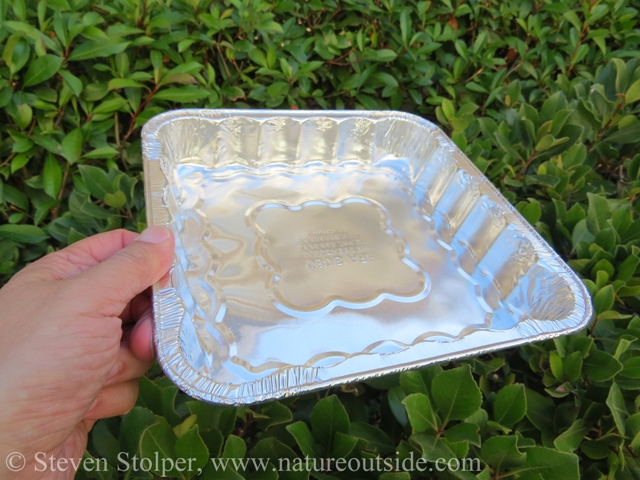
Before…
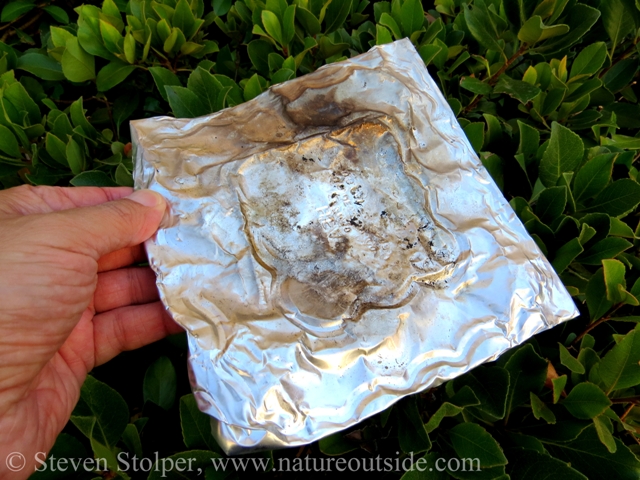
After!
Experiment with both techniques and a wide variety of tinder. What works well? What doesn’t? Let me know in the comments below.
More Fire on NatureOutside
How to Make a Custom Firesteel without Fancy Tools
Don’t get burned: Carrying matches in the outdoors



Nicely laid out post with good information. I’d never really thought about needing to use only one hand, but I will be trying that method. Hopefully I’ll never need it for real.
Totally agree with the need for accuracy in dropping the sparks.
This video link ( I am in no way affiliated or connected to the maker) backs up all the points you make here and also how to use a non squared spine knife (Mora) to good effect.
Many thanks.
https://youtu.be/D5R0uFHcfQw
Colin, I’m glad you enjoyed the article. Thank you for your comment and the link to the video. Paul looks so young in that video! 🙂
The best part of your knife to use is the sharp edges bevel at the tip of your knife, not the cutting edge of course but the back where the bevel meets the spine. This is always sharp, or should be. It takes a bit more practice but works very well and you can still get the end of your fire steel right in mongst the tinder. Always fluff up your tinder, the same laws that govern all fires are at work here, you need fuel and oxygen, also the small fragments have many thin edges that don’t need to be heated up so much before they burst into flame.
Thanks for the great tips, Steve!
Hi Steve!
Great article!
I have got to learn how to light a candle with a fire steel.
Do you have a video?
New candle or previously lit?
Going to practice!
Tommy, many people practice lighting candles from a firesteel. It’s a good challenge to see if you can get the spark onto the wick. I find it difficult to do. I’ve tried with tealight candles, Chanukah candles, and trick birthday candles. And I need many tries to get the spark to light the wick.
So I do not carry candles that I expect to light with a firesteel. In the backcountry, I want a “no brainer” way to kindle a fire. So I use the firesteel with prepared tinder or fluffy natural tinder. For candles, I plan to use matches or a lighter.
“I purchase cheap disposable aluminum foil baking pans. I cut into the sides of the pans at the corners and fold-over the sides. This creates a raised metal platform.”
Just wondering why you didn’t just turn it upside down?
Great question, Tony! The foil the disposable pans are made from is thin. If you exert downward pressure on them when they are upside-down the side walls or bottom can deform or collapse. When I use my firesteel, I exert downward pressure onto the part of my firesteel in contact with the tinder. This holds the tinder in place and helps uncoordinated people like me hold the firesteel steady as I strike the spark.